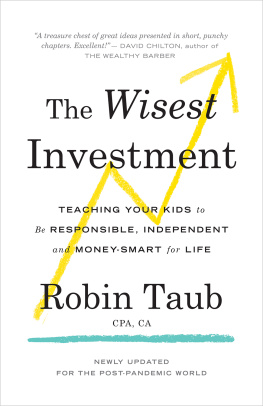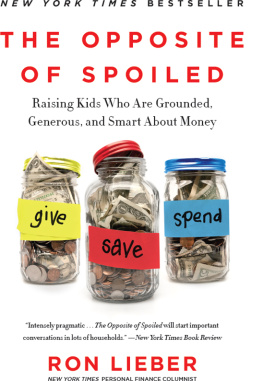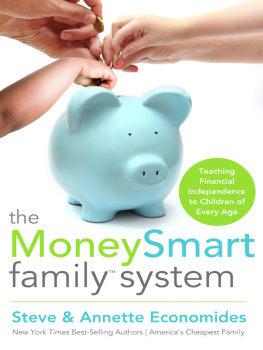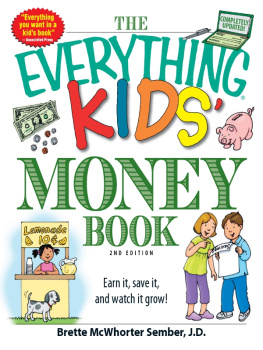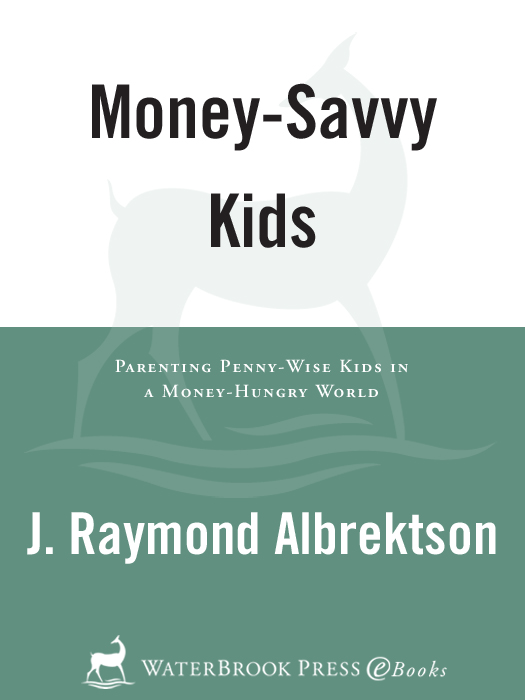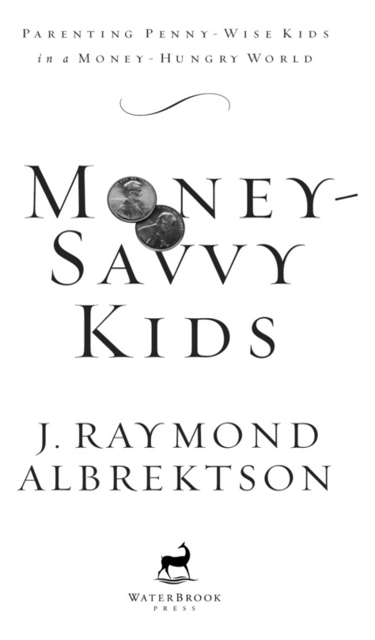M ONEY -S AVVY K IDS
P UBLISHED BY W ATER B ROOK P RESS
12265 Oracle Boulevard, Suite 200
Colorado Springs, Colorado 80921
Scripture taken from the Holy Bible, New International Version. NIV. Copyright 1973, 1978, 1984 by International Bible Society. Used by permission of Zondervan Publishing House. All rights reserved.
Details in some anecdotes and stories have been changed to protect the identities of the person involved.
eISBN: 978-0-307-76894-0
Copyright 2002 by J. Raymond Albrektson
Published in association with the literary agency of Janet Kobobel Grant, Books & Such, 4788 Carissa Ave., Santa Rosa, CA 95405.
All rights reserved. No part of this book may be reproduced or transmitted in any form or by any means, electronic or mechanical, including photocopying and recording, or by any information storage and retrieval system, without permission in writing from the publisher.
Published in the United States by WaterBrook Multnomah, an imprint of the Crown Publishing Group, a division of Random House Inc., New York.
W ATER B ROOK and its deer colophon are registered trademarks of Random House Inc.
Library of Congress Cataloging-in-Publication Data
Albrektson, J. Raymond.
Money-savvy kids : parenting penny-wise kids in a money-hungry world / J. Raymond Albrektson.
p. cm.
1. WealthReligious aspectsChristianity. 2. MoneyReligious aspectsChristianity. 3. ParentingReligious aspectsChristianity. I. Title.
BR115.W4 A43 2001
241.68085dc21
2001045631
v3.1
TO MY CHILDREN, LAURIE AND JOSH,
from whom I never cease to learn
new and wonderful things
Contents

1. Hope for the Financially Flawed
Your Kids Can Learn from Your Mistakes
2. Money Management and Godly Character
Winning at the Game of Life
3. Each Kid Is Different
Take Advantage of Your Childs Unique Bent
4. I Am Justins College Fund
The Sooner You Start, the Less Scary It Will Be
5. Work Isnt a Dirty Word
Finding Its Meaning and Value
6. A Wealth of Chores
Why Everyone Needs to Pitch In
7. Baby-Sitting and Lawn Care
Your Childs Home-Based Business Ventures
8. But I Want a Real Job!
When Your Child Becomes a Part-Time Employee
9. Generosity Begins in the Sandbox
Its Never Too Early to Teach Openhandedness
10. Teaching Joyful Giving
Adding a Smile to Openhandedness
11. The Lesson of Allowances
A Little Cash Can Be the Key to Independent Giving
12. The Teenage Philanthropist
Helping Your Adolescent Cultivate Generosity
13. The Power of Deferred Gratification
The Best Answer to I Want It Now!
14. The Trouble with the Piggy Bank
Break It Now! Go Ahead
15. Getting Chummy with Numbers
Dont Let a Fear of Math Get in the Way
16. Investment Basics for Third Graders
Help for Parents Who Get Nervous Around Mutual Funds
17. I Am Justins Investment Portfolio
Help Your Child Grow with the Market
18. A Positive View of Consequences
Choices Lead to ResultsBoth Good and Bad
19. Whats Great About Allowances
Four Principles That Make Allowances Work
20. I Am Justins Checkbook
Bookkeeping 101 for Kids
21. A Practice Run for Adulthood
From Rug Rat to Rat Race
22. The Drivers License
Turn Drivers Ed into Character Ed
23. Cars and College
It Doesnt Have to Be One or the Other
24. If a Teen Goes Bad
How You Can Limit the Damage
25. The Hot-Stove Principle
Teaching a Healthy Fear of Debt
26. Kids in College
Your Semiadults Still Need Parents
27. Emptying the Nest ...
Without Chucking Out the Kids
Acknowledgments

I want to acknowledge the support and encouragement of my friends in the Plot & Blot Society: Gary Stanley, Alan Scholes, Janet Kobobel Grant, and Kirsten Wilson. Ben Franklin once wrote, Either write something worth reading or do something worth writing. These four have encouraged me by doing both.
Introduction
What We Want for Our Children

Buying eight-hundred-dollar suits and Ferragamo shoes, daytrading in his dorm room, and running up five-figure credit-card debts through betting on the outcome of NFL gamesnot exactly the way you expected Justin to spend the money earmarked for his college education, is it? Todays kids are at greater risk than ever before of buying into the instant-wealth culture that dominates our society. The get-rich-quick mind-set and the quest for instant gratification have permeated our culture, and your family isnt immune.
Are you hoping that your kids will study hard, prepare themselves for useful careers, and then land good jobs and start families? In other words, turn into successful, financially independent adults? I thought so. But what parents hope for and what actually happens are often at odds. Check out these other, all-too-realistic scenarios.
H IGH -R ISK I NVESTING
Brad earned seven thousand dollars toward his college education through hard work during high school. His parents, a middle-class working couple, added considerably to that amount, but Brad ended up taking out an eight-thousand-dollar student loan to finish his senior year. That same year, Brad received a letter from a well-known brokerage firm and was invited to open an account. He parked his loan moneyall eight thousand dollarsin a high-yield mutual fund growing at almost 18 percent per year.
Within two months, he decided to try for a better return from an even higher-risk investment. He had friends who helped him buy and sell a few hundred shares of stock. He made a few lucky trades and found himself suddenly two thousand dollars richer. This was too good to be true!
It wasnt long before he began making trades in companies that he knew little about. He wasnt worried though. All his friends were involved in online trading, and he was getting some great tips. Then his run of luck ended, and he lost one-third of his college loan. Thats when he panicked. How could he get that money back? He heard the magic words: Trade options! Its great. Everybodys doing it! By Thanksgiving Brads investment account was empty. He had no cash left to pay for winter-quarter classes.
C REDIT -C ARD D EBT
Like Brad, Candace came from a middle-class background. She and her parents teamed up to pay most of her college expenses. In addition, she had received scholarships and a gift from her grandmother, so Candace had all she needed to finish her degree without taking out any student loans.
At fall registration of her freshman year, she was offered an expensive set of facial cleansers and moisturizers just for signing up for a credit card. Two years later she was maxed out on six credit cards, and her college funds were being drained just to make the minimum payments on her debt. Candace was afraid to tell her parents, and when she finally ran out of money in the spring of her junior year she owed more than twenty-eight thousand dollars in high-interest credit-card debt.


